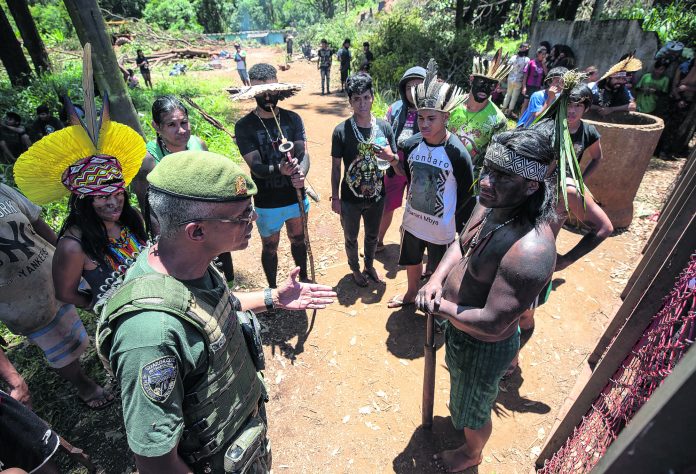
Their bodies painted black, dozens of members the Brazil’s Guarani Mbya tribe lift their hands and sing a mourning song for hundreds of felled trees beside their village. They weep, chant and perform funeral rites for a lost patch of forest on the edge of Latin America’s biggest city.
People in the tribe rushed to the site, at the base of Sao Paulo’s Jaraguá Peak, as soon as they heard chainsaws toppling trees on Jan. 30. Some wore feathered headdresses and held arrows in clenched fists. The display alarmed construction company employees, who called the police and sought refuge in a shack nearby.
“Two employees of the company came in December to tell us not to be scared about the chainsaws,” tribal leader David Fernandes told The Associated Press. “There’s no city here. There’s just forest. How can the authorities give a license to build here? There has been no dialogue. It is our right to have a say about what impacts us.”
Tree-cutting has been suspended, at least temporarily. But workers still hope to get back to building five high-rise apartment blocks for low-income residents. Sao Paulo’s city hall said it had awarded licenses to build there.
They were given by officials working for Mayor Bruno Covas, a former state environment secretary who is running for reelection this year.
Until the 1950s, the tribe wandered in the Jaraguá region, an area of Atlantic forest. Decades later, the village they settled in was recognized by the Brazil government but also encroached upon by the sprawling metropolis. The tension between a builder with projects in nine Brazilian states and a 40-family indigenous community — the smallest by area in all Brazil at 4.2 acres (1.7 hectares) — is a microcosm of what’s playing out elsewhere in the country.
Farther afield, particularly in Brazil’s Amazon, indigenous groups face growing pressure from business interests including loggers, miners, farmers and cattle ranchers. The developers have found a steadfast advocate in President Jair Bolsonaro, who has often said indigenous people and their land cannot be a hindrance to development and national sovereignty.
Brazil’s president has no say in awarding the constructor the permits to build near Guarani Mbya land. But tribal leaders argue the federal indigenous affairs agency did not consult them on potential impacts, as required by law, which would halt the licensing process. They also said no one from the agency, known as Funai, supported them after they informed about the construction.
Funai said Tuesday that officials visited the site recently. In a statement the agency said the cutting of trees was suspended for 20 days following an agreement between indigenous leaders and the construction company. It did not comment on whether it had consulted the indigenous residents before tree-felling began.
Sao Paulo’s city hall said Tuesday night that construction at the site will be halted for seven days so the indigenous people have more time to provide any evidence that there are problems with the builder’s environmental licenses.
Earlier, builder Tenda said it had carried out all required procedures to begin the housing project and felled only “isolated trees.” Following repeated requests from the AP, Tenda didn’t make anyone available for an interview.
Tribal leaders are concerned that the roughly 500 trees felled over the past week is just the start, and that more trees will be cut. The indigenous group worries that amount of deforestation could dry up a spring that’s important for local fishing.
The Guarani Mbya officially gained claim to their land, an area smaller than two soccer pitches beside Sao Paulo’s tallest hill, in 1987. While Tenda isn’t building on the indigenous territory, Sao Paulo city councilman Gilberto Natalini says granting permission to build near the tribe and in a forested region still is a “disgrace” and a sign of greed.
“In Brazil, the order now is destroy in order to make money,” Natalini said, walking amidst fallen trunks. “It’s a very bad moment for our environment.”
Bolsonaro has said indigenous people should be integrated into society, and also that they themselves desire modern conveniences. He has likened those living within protected areas to animals trapped in a zoo, angering human rights activists.
Not all the Guarani Mbya cling to traditional habits. Unlike in some other Brazilian tribal villages, few children run around naked, especially because of Sao Paulo’s often chilly weather. The youngest wear soccer shirts, while others carry cell phones and drive old cars on dirt roads to carry supplies for their families. Many have left the community, abandoning their culture altogether.
But a quick walk around shows many of the 700 Guarani Mbya like to stay near one another, telling stories, praying in their clay huts and eating fruit from their own trees. They express their wish to maintain their distance from the metropolis, even if it means having shoddy housing and a lack of sewage treatment.
“I never wanted to live there, but the city insists on coming to us,” tribe member Balbina Terue said. “I don’t see why people have to destroy the environment just to live here.”
On Sunday, the tribe suspended their ceremony and dispatched children to plant 200 trees on Tenda’s land. It was a merely symbolic gesture, since the saplings of various cedars and oaks may never reach the heights of the trees that were recently removed. “This will not solve the problem for us,” Fernandes conceded. “But maybe it helps future generations.”
Those generations, however, just might live in apartments.



















